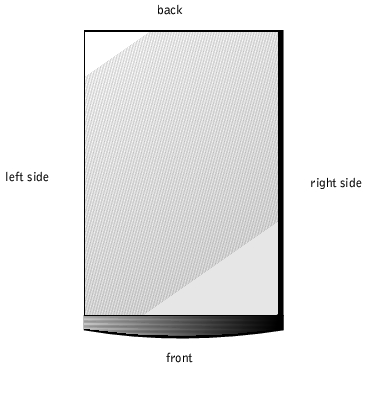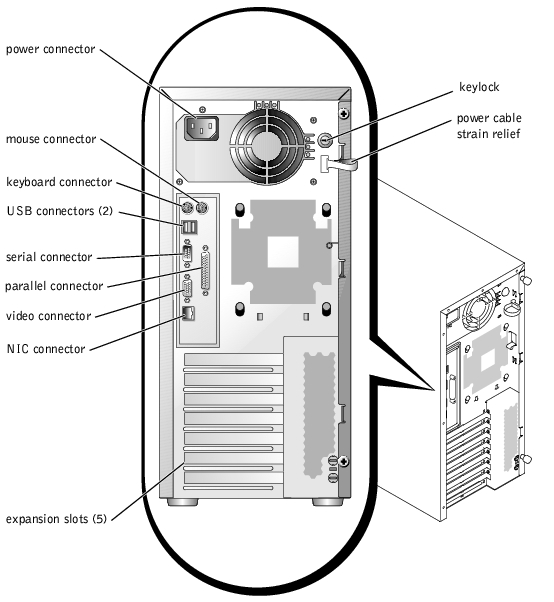 System Orientation
System OrientationDell™ PowerEdge™ 600SC Systems User's Guide
 Front-Panel Indicators and Features
Front-Panel Indicators and Features
 Obtaining Technical Assistance
Obtaining Technical Assistance
Your system provides a reliable platform for both large and small customers. This section describes the major hardware and software features of your system, provides information about the indicators on the system's front panel, and discusses connecting external devices to the system. It also provides information on obtaining assistance from Dell.
When following the procedures in this guide, assume that the locations or directions relative to the system are as shown in Figure 1-1.
Figure 1-1. System Orientation (Viewed From Above)

Figure 1-2 shows the indicators and features located on the system's front panel.
Figure 1-2. Front-Panel Features

Figure 1-3 shows the back-panel features of the system.
Figure 1-3. Back-Panel Features

When connecting external devices to your system, follow these guidelines:
For information about enabling, disabling, and configuring I/O ports and connectors, see "Using the System Setup Program."
Your system offers the following features:
or
An Intel Pentium 4 Celeron® microprocessor with a speed of at least 1.7 GHz, a front side bus speed of 400 MHz, and a 128-KB Level 2 cache
The system board includes the following built-in features:
Standard systems include an IDE CD drive and diskette drive, installed in an externally accessible bay.
The following software is included with your system:
Your system supports the following operating systems:
A number of devices are available that protect against power problems such as power surges, transients, and power failures. The following subsections describe some of these devices.
Surge protectors are available in a variety of types and usually provide a level of protection commensurate with the cost of the device. Surge protectors prevent voltage spikes, such as those caused during an electrical storm, from entering a system through the electrical outlet. Surge protectors, however, do not offer protection against brownouts, which occur when the voltage drops more than 20 percent below the normal AC line voltage level.
Line conditioners go beyond the overvoltage protection of surge protectors. Line conditioners keep a system's AC power source voltage at a fairly constant level and, therefore, can handle brownouts. Because of this added protection, line conditioners cost more than surge protectors—up to several hundred dollars. However, these devices cannot protect against a complete loss of power.
UPS systems offer the most complete protection against variations in power because they use battery power to keep the system running when AC power is lost. The battery is charged by the AC power while it is available, so once AC power is lost, the battery can provide power to the system for a limited amount of time—from 15 minutes to an hour or so—depending on the UPS system.
UPS systems range in price from a few hundred dollars to several thousand dollars, with the more expensive units allowing you to run larger systems for a longer period of time when AC power is lost. UPS systems that provide only 5 minutes of battery power let you conduct an orderly shutdown of the system, but are not intended to provide continued operation. Surge protectors should be used with all UPS systems, and the UPS system should be UL safety-approved.
Besides this User's Guide, the following documentation is included with your system:

|
The System Information Guide provides important safety and regulatory information. Warranty information may be included within this document or as a separate document. |
You may also have one or more of the following documents.
 |
NOTE: Documentation updates are sometimes included with your system to describe changes to your system or software. Always read these updates before consulting any other documentation because the updates often contain the latest information. |
If at any time you do not understand a procedure described in this guide or if your system does not perform as expected, Dell provides a number of tools to help you. For more information on these help tools, see "Getting Help" in your Installation and Troubleshooting Guide. Dell Enterprise Training and Certification is available now; see www.dell.com/training for more information. This service may not be offered in all locations.